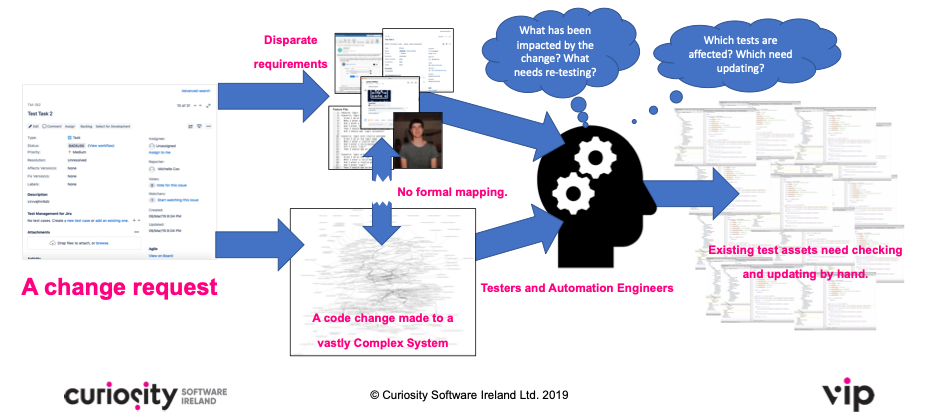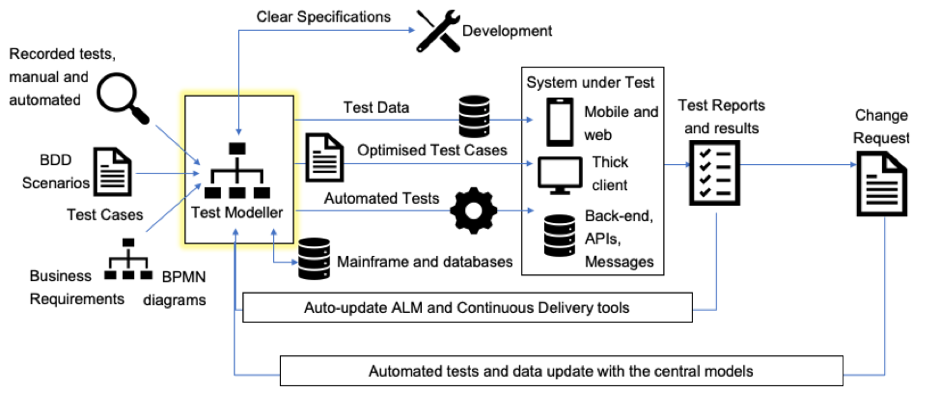5 Reasons to Model During QA, Part 3/5: Coverage Focuses QA
Welcome to part 3/5 of 5 Reasons to Model During QA! Part one of this series discussed how modelling enables “shift left” QA, eradicating potentially...
Design Complex Systems, Create Visual Models, Collaborate on Requirements, Eradicate Bugs and Deliver Quality!
| Product Overview | Solutions |
| Success Stories | Integrations |
| Book a Demo | Release Notes |
| Free Trial | Brochure |
| Pricing |
Our innovative solutions help you deliver quality software earlier, and at less cost!
![]() AI Accelerated Quality Scalable AI accelerated test creation for improved quality and faster software delivery.
AI Accelerated Quality Scalable AI accelerated test creation for improved quality and faster software delivery.
![]() Test Case Design Generate the smallest set of test cases needed to test complex systems.
Test Case Design Generate the smallest set of test cases needed to test complex systems.
![]() Data Subsetting & Cloning Extract the smallest data sets needed for referential integrity and coverage.
Data Subsetting & Cloning Extract the smallest data sets needed for referential integrity and coverage.
![]() API Test Automation Make complex API testing simple, using a visual approach to generate rigorous API tests.
API Test Automation Make complex API testing simple, using a visual approach to generate rigorous API tests.
![]() Synthetic Data Generation Generate complete and compliant synthetic data on-demand for every scenario.
Synthetic Data Generation Generate complete and compliant synthetic data on-demand for every scenario.
![]() Data Allocation Automatically find and make data for every possible test, testing continuously and in parallel.
Data Allocation Automatically find and make data for every possible test, testing continuously and in parallel.
![]() Requirements Modelling Model complex systems and requirements as complete flowcharts in-sprint.
Requirements Modelling Model complex systems and requirements as complete flowcharts in-sprint.
![]() Data Masking Identify and mask sensitive information across databases and files.
Data Masking Identify and mask sensitive information across databases and files.
![]() Legacy TDM Replacement Move to a modern test data solution with cutting-edge capabilities.
Legacy TDM Replacement Move to a modern test data solution with cutting-edge capabilities.
See how we empower customer success, watch our latest webinars, read our newest eBooks and more.
![]() Events Join the Curiosity team in person or virtually at our upcoming events and conferences.
Events Join the Curiosity team in person or virtually at our upcoming events and conferences.
![]() Blog Discover software quality trends and thought leadership brought to you by the Curiosity team.
Blog Discover software quality trends and thought leadership brought to you by the Curiosity team.
![]() Help & Support Find a solution, request expert support and contact Curiosity.
Help & Support Find a solution, request expert support and contact Curiosity.
![]() Success Stories Learn how our customers found success with Curiosity's Modeller and Enterprise Test Data.
Success Stories Learn how our customers found success with Curiosity's Modeller and Enterprise Test Data.
![]() Documentation Get started with the Curiosity Platform, discover our learning portal and find solutions.
Documentation Get started with the Curiosity Platform, discover our learning portal and find solutions.
![]() Integrations Explore Modeller's wide range of connections and integrations.
Integrations Explore Modeller's wide range of connections and integrations.
Curiosity are your partners for designing and building complex systems in short sprints!
![]() Meet Our Team Meet our team of world leading experts in software quality and test data.
Meet Our Team Meet our team of world leading experts in software quality and test data.
![]() Our History Explore Curiosity's long history of creating market-defining solutions and success.
Our History Explore Curiosity's long history of creating market-defining solutions and success.
![]() Our Mission Discover how we aim to revolutionize the quality and speed of software delivery.
Our Mission Discover how we aim to revolutionize the quality and speed of software delivery.
![]() Our Partners Learn about our partners and how we can help you solve your software delivery challenges.
Our Partners Learn about our partners and how we can help you solve your software delivery challenges.
![]() Careers Join our growing team of industry veterans, experts, innovators and specialists.
Careers Join our growing team of industry veterans, experts, innovators and specialists.
![]() Press Releases Read the latest Curiosity news and company updates.
Press Releases Read the latest Curiosity news and company updates.
![]() Success Stories Learn how our customers found success with Curiosity's Modeller and Enterprise Test Data.
Success Stories Learn how our customers found success with Curiosity's Modeller and Enterprise Test Data.
![]() Blog Discover software quality trends and thought leadership brought to you by the Curiosity team.
Blog Discover software quality trends and thought leadership brought to you by the Curiosity team.
![]() Contact Us Get in touch with a Curiosity expert or leave us a message.
Contact Us Get in touch with a Curiosity expert or leave us a message.
4 min read
 Thomas Pryce
07 August 2019 15:07:51 BST
Thomas Pryce
07 August 2019 15:07:51 BST

Welcome to part 4/5 of 5 Reasons to Model During QA! If you have missed any previous instalments, use the following links to see how modelling can:
Model-Based Testing further enables testing to react to fast-changing applications, rapidly updating test suites to validate a change made to the code. This flexibility and resilience is the focus of today’s article, discussing how modelling accurately forecasts the complexity of a change and automates test maintenance.
Software applications today are both massively complex and fast-changing. Short iterations bring code commits on a monthly, weekly, or daily basis, and QA must validate the success of each update.
These fast QA reaction times require an approach that is:
Resilient:Testing must be able to maintain test coverage, identifying and creating all test assets needed to validate a change. This must happen in the same iteration as the change was made, otherwise chunks of the code will go untested.
Flexible: QA must be able to maintain test suites at the pace of which applications change, adopting a reactive and flexible stance to test maintenance.
However, most organisations instead face an undesirable choice between QA flexibility and QA resilience. Their current testing practices mean there is not enough time in an iteration to identify, create, and execute every test required to validate a change made to the code.
Test teams cannot therefore fully test a change within the same iteration as the change was made, and code changes in turn risk costly defects in production. Fortunately, there is a way that QA can achieve the resilience and flexibility required to continuously implement change: modelling.
Two broad barriers prevent QA from keeping up with the rate of change: identifying what needs to be tested after a change, and then updating or creating the test assets needed to validate the change.
A change request today often constitutes a new user story or request that is sent to developers. These requests enters the bag of disparate and unconnected requirements that make up a system. These requirements were discussed in part one of this series.
The disparate requirements are not formally mapped to one another, and there is therefore no automated way to identify which parts of a system have been identified by a new change request. If a new Gherkin Specification is created, for instance, how can BAs, developers and testers reliable assess the impact of one Behaviour-Driven Scenario across the multitude of interrelated parts in a system?
The challenge of change requests.
Identifying the interdependent parts of a system that have been impacted by a system is often guesswork in this scenario, as is assessing the complexity of a change. Low priority changes can have unforeseen impacts across a complex system, requiring testing and development efforts that are disproportionate to the value of the change.
The responsibility of QA is to identify these problematic and unforeseen consequences of a change. However, testers also lack the ability to reliably identify the impact of a change, by virtue of formal dependency mapping in the requirements.
Then there’s time needed to create or update any tests required to validate a change.
Part two of this series set out the bottlenecks associated with manually creating test cases, test data and automated test scripts. Often, much of this effort is repeated after a change, forcing tests to roll-over constantly to the next iteration.
Manually created test assets are rarely traceable to the system designs, and nor are they typically linked to one another. Testers must therefore analyse existing tests one-by-one to identify the impact of a change on a regression pack. They must then update the test cases, test data and automated tests, keeping all three aligned.
QA teams must additionally create the tests needed to test new functionality, but there is little time in a sprint for both test maintenance and manual test creation.
Alternatively, invalid tests might go unchecked, piling up in the regression pack. These invalid tests will then throw up defects when there are no genuine bugs in the code, while bad test data will destabilise test automation frameworks.
A new approach is instead required, identifying the impact of changes made to a system and reflecting them efficiently in test suites.
Model-Based Testing, with the right tools and techniques, introduces the flexibility needed to update test assets in time, as well as the QA resilience to continually test with rigour. The impact of changes can further be forecast in advance, enabling evidentially-based software design decisions.
Flowchart modelling first enables you to measure the impact of a change in advance. BAs, developers and testers can rapidly incorporate a change request into the model, or might make the request using the model itself. The paths through the updated model can then be identified automatically using mathematical algorithms.
These paths are equivalent to tests, and the number of paths impacted thereby provides a test-driven measure of complexity. This offers a reliable and standardised way to measure the relative value of a change against the impact of implementing it.
This impact analysis can extend beyond individual components, using subflows to create dependency maps of a system. The subflows group lower level logic in master flows. The impact of a change made to one subprocess is then identifiable in the master flowcharts, as well as downstream in the child models.
Modelling also removes the second challenge of change for QA: manual test maintenance.
Parts two and three of this series discussed how test cases, test data and test scripts are all traceable to the models from which they were generated. As those models change, the optimised test suite is regenerated rapidly. Test teams might further create coverage profiles to target the affected logic with a greater degree of rigour, focusing regression on logic impacted by the last code commit.
Reactive test automation, driven by central flowchart models.
QA in this approach becomes an automated comparison of the logic specified in the models, to the system reflected in the code. As an organisation’s understanding of the ideal system changes, the models evolve. This auto-updates the rigorous test suite that is tied to those models, continuously testing fast-changing systems.
Regenerating a set of linked test cases, data and scripts is generally far quicker and more reliable than attempting to keep individual assets aligned manually. Modelling therefore provides the QA resilience and QA flexibility needed to deliver fast-changing applications that accurately reflect the latest business requirements.
[Image: Pixabay]

Welcome to part 3/5 of 5 Reasons to Model During QA! Part one of this series discussed how modelling enables “shift left” QA, eradicating potentially...

Model-Based Testing (MBT) itself is not new, but Model-Based Test Automation is experiencing a resurgence in adoption. Model-Based Testing is the...

Each year, organisations and consumers globally depend on Oracle FLEXCUBE to process an estimated 26 Billion banking transactions [1]. For...

Welcome to the final instalment of 5 Reasons to Model During QA! If you have missed any of the previous four articles, jump back in to find out how...

Throughout the development process, software applications undergo a variety of changes, from new functionality and code optimisation to the removal...

There is no longer any doubt in the industry that test automation is beneficial to development; in fact, more than half of development teams have...

IT change remains a persistent struggle for most organisations today. Software teams are aware of the need to move faster and be more agile; yet,...

Since the initial launch of ChatGPT, interest in AI has exploded across almost every industry sector. The unique ability to solve problems by...

We rarely post ‘product’ articles here at Curiosity, preferring instead to draw on our team’s thought and expertise. This article is no different,...